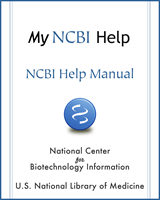NCBI Bookshelf. A service of the National Library of Medicine, National Institutes of Health.
My NCBI Help [Internet]. Bethesda (MD): National Center for Biotechnology Information (US); 2005-.
The Saved Searches feature facilitates saving search queries for NCBI databases, and provides automatic e-mail updates for saved searches, which can be set up on a daily, weekly, or monthly basis.
NCBI started the transition to use only federated account credentials for NCBI account login on June 1st, 2021. The deadline for transitioning all NCBI accounts to 3rd-party only login is June 2022. Please read the below FAQs and write to vog.hin.mln.ibcn@ofni if you have any questions.
https://ncbiinsights.ncbi.nlm.nih.gov/ncbi-login-retirement-faqs
Section Contents
Saving a Search in My NCBI
- 1.
On any database page, run a search—make sure you are signed in to NCBI (B in image below).
- 2.
In PubMed, click on Create alert, located below the search box. (A). If you are using other NCBI databases, click Save search.

3. You will be guided to your My NCBI Saved searches page where you may edit the name of the search; up to 100 characters are allowed. The name of the saved search will be included in the Subject line of the automatic e-mail update messages.
4. If the database you searched supports e-mail updates, you will be prompted to set up automated e-mail preferences at this time. Or, if you prefer, this can be set up at a later time. Click Save. (C in image below.)
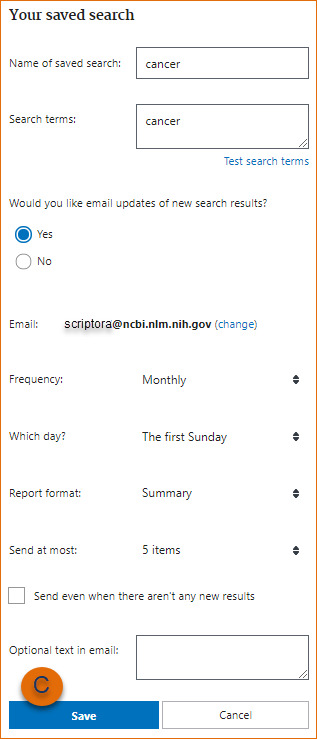
Note:
- Your saved searches will be listed in the “Saved Searches” section of My NCBI. Searches are grouped per database and listed by the date they were saved for the first time
- Dates and date ranges are not advisable for saved searches
- Links to Related Citations cannot be saved in My NCBI
- Accounts that do not have any activity in two years will be deleted
Setting up Automatic E-mail Updates
In most NCBI databases*, when you click on Create alert you are asked if you would like to receive e-mail updates of new search results automatically. Automatic e-mail updates of search results are then sent according to the frequency you selected when saving your search in My NCBI (monthly, weekly, or daily). You can also choose a format (Summary, Abstract, Summary text, Abstract text, PubMed), optional text (up to 200 characters), and change the number of items to be sent (1, 5, 10, 20, 50, 100 or 200 items).
The text, which appears in the body of your e-mail updates, can be used to create a title for your search or any specific information you want. You may enter up to 100 characters for the search title. The name of the saved alert will be included in the Subject of your automated e-mail update messages. If you have trouble remembering your original search word or phrase(s), hover over the search name with your mouse in My NCBI - Saved Searches. It will display the original search word or phrase(s).
Automatic e-mail updates can only be sent to e-mail addresses that have been confirmed.
In the rare case of technical problems, updates may miss some citations. Users receiving automatic updates should use the option to link to view complete results to minimize the risk.
*NCBI databases that support e-mail updates are:
CDD, GEO DataSets, Genome, NLM Catalog, Nucleotide, PopSet, PubChem BioAssay, PubChem Compound, PubChem Substance, PubMed, PubMed Central, Protein, SNP, SRA, Structure, Taxonomy.
Note:
- If an e-mail update cannot be delivered three times, the e-mail address will be changed to invalid
- Each My NCBI account can only have one e-mail address
- In the event an update is not sent out on schedule or is incomplete, the next scheduled update will include the omitted items, if any
- E-mail updates may be affected by e-mail filtering SPAM software. Consider adding nih.gov domain to your e-mail “safe list.” If your settings do not allow you to add e-mail addresses to a safe list, consult the help section of your e-mail program, or contact your e-mail/Internet provider's customer support to research your configuration options.
Changing the E-mail Schedule of Your Updates
To change or create a schedule for a saved alert, go to the Saved Searches portlet, click the gear icon  next to the search you wish to edit, it will lead you to the same page where you initially saved a search and set up an e-mail schedule. You can then change the e-mail schedule or any other settings you would like.
next to the search you wish to edit, it will lead you to the same page where you initially saved a search and set up an e-mail schedule. You can then change the e-mail schedule or any other settings you would like.
To see the e-mail schedule for all your saved searches at once, click “Manage Saved Searches.”
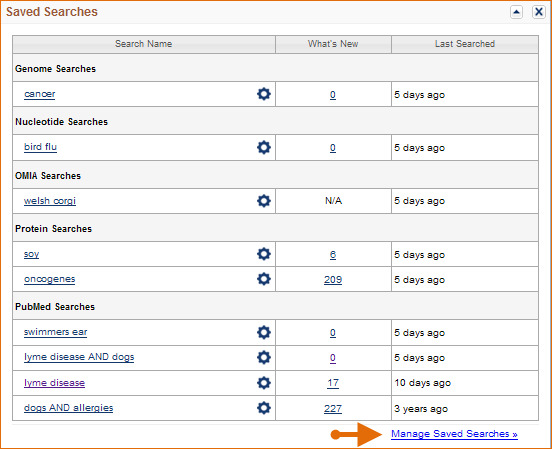
If you have set up an e-mail schedule to receive search updates, this information is displayed in the Schedule column. For searches that you have not set up a schedule or which were run in databases that do not offer this feature, you will see none displayed in the Schedule column.
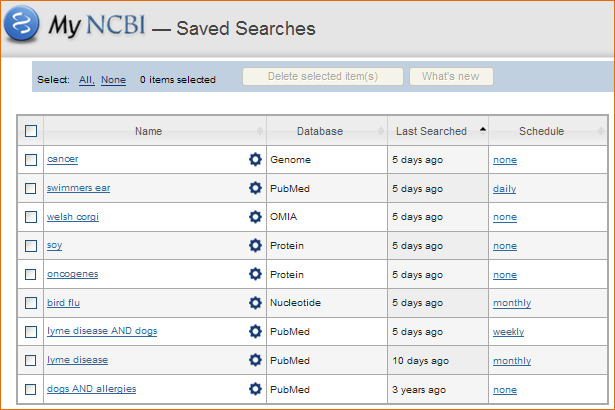
Running Saved Searches and Checking for New Results
Sign in to My NCBI. Go to the Saved Searches portlet, where all searches are listed by database. Click on the search name to run the saved search in its respective database. This will not change the date displayed in the Last Searched column (A in the image below). To see the exact date when a search was last run on a database, place your mouse over the date shown under “Last Searched.”
To check for new results, click on the hyperlinked number next to your saved search and under the What’s New column (B). The hyperlinked number indicates how many new items were found since the last time the search was run. This action will change the date in the Last Searched column.
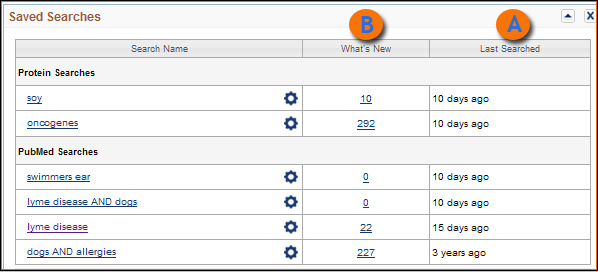
Not all NCBI databases support automatic updates. In those cases, the option What’s New will not be available.
The below strategy is applied to searches with untagged terms and searches that do not use filters.
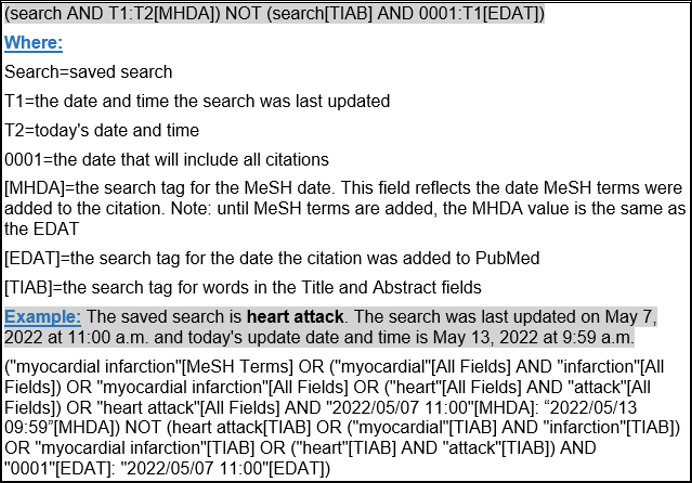
Note (for PubMed):
- My NCBI "remembers" the date and time new items were last retrieved for your Saved Searches. For strategies without search tags, it also considers whether citations that were in-process (not yet indexed) the last time you updated have since had MeSH terms applied, and are now retrieved by your strategy
- My NCBI saved searches that include search field tags or selections from the filters sidebar use an abbreviated “What’s New” search to ensure that all citations are retrieved
- Searches that include PubMed search field tags FAU, IR, 1AU, LASTAU, CN, AU, PS, IP, TA, LA, PG, TI, TIAB, LID, JID, TT or VI, use the strategy: Search AND T1 : T2 [EDAT]
- Searches that include search field tags other than the ones listed above, use the strategy: Search AND T1:T2 [MHDA]
- The My NCBI “What’s New” feature will not retrieve citations for articles that were published more than one year ago
- To retrieve all new citations regardless of publication date, do not use either the “e-mail updates” or “What’s New” options for My NCBI Saved Searches. Rather, run the saved search and combine it with a Create Date range. Use the format yyyy/mm/dd: yyyy/mm/dd [crdt]. For example: "lyme disease"[MeSH Terms] 2020/01/01:2020/06/18[crdt]. For further information on searching by date see Searching by Date.
Sorting Searches
To sort Saved Searches, click the “Manage Saved Searches” link.
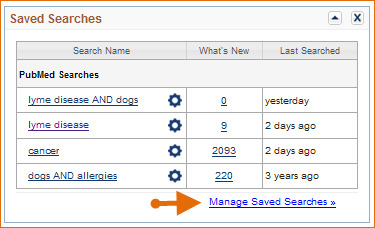
Click on a column name, and then on the small black arrow to change the ascending or descending order. Searches can be sorted:
- alphabetically by name
- by database
- by date last searched
- by schedule
Modifying a Search Query
To modify a saved search query:
- 1.
Sign in to My NCBI.
- 2.
In the Saved Searches module; click the gear icon
 next to the search you wish to edit; it will lead you to the same page where you initially saved a search.
next to the search you wish to edit; it will lead you to the same page where you initially saved a search.
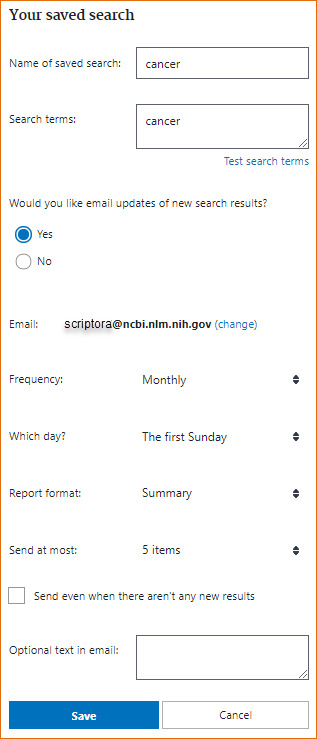
3. You can then edit the search terms or any other settings available in this page.
4. Be sure to click Save to keep the amended search query.
Deleting a Search
- 1.
Go to the Saved Searches page, click the “Manage Saved Searches” link.
- 2.
Check the box next to the name of the search you want to delete.
- 3.
Click the button Delete selected item(s). A confirmation window will appear, click OK.
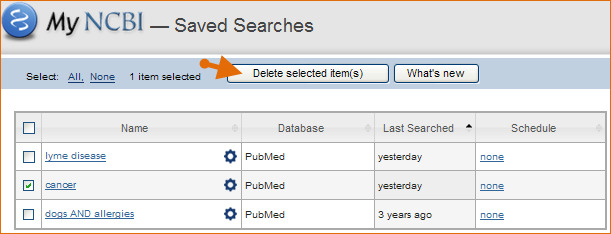
- Saving and Managing Searches - My NCBI HelpSaving and Managing Searches - My NCBI Help
Your browsing activity is empty.
Activity recording is turned off.
See more...
